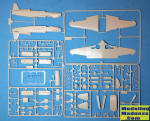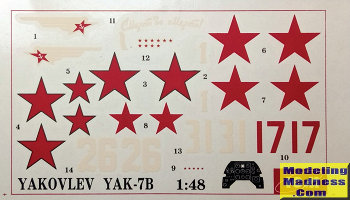
| KIT #: | 48032 |
| PRICE: | €15 when new |
| DECALS: | Four options |
| REVIEWER: | Spiros Pendedekas |
| NOTES: |

| HISTORY |
Developed from the earlier Yak-1 fighter, the Yakovlev Yak-7 was initially developed as a trainer and later also converted into a fighter. Simpler, tougher and generally better than its predecessor, it proved to be a capable aircraft, well liked by air crews.
| THE KIT |
 ICM
came in 1998 with its new tool quarter scale Yak-7 /early Yak-9 line, covering,
with the addition of extra/new parts, most, if not all of the above sub
variants. These successful kits were reboxed by Ark Models, Alanger and Maquette.
ICM
came in 1998 with its new tool quarter scale Yak-7 /early Yak-9 line, covering,
with the addition of extra/new parts, most, if not all of the above sub
variants. These successful kits were reboxed by Ark Models, Alanger and Maquette.
The specific kit is the 1999 Yak-7B version, bought in 2003 from an Athens hobby
shop at a very good price. It comes in a small, flimsy, side opening box,
featuring an attractive box art of a 434 IAP’s ski-equipped example taxiing on a
snowy runway.
Upon opening the box, I was greeted with 101 cream colored styrene parts,
arranged in four sprues: one containing the fuselage halves, one the wing
halves, with the other two containing all the rest. Since the sprues are common
with other variants, not all parts are to be used for the specific version.
Molding is crisp, with only minimal flash noted at one of the prop blades,
surface texture is good and panel lines are nicely engraved. Some amounts of
mold release agent were evident on the sprues, meaning that the latter should be
thoroughly washed/cleaned before starting.
Cockpit is very well represented, featuring, among others, the distinctive
tubular framing found at the real thing. A complete engine with sufficient
detail is provided, in case you want to display it. The tiny exhausts look good,
as does the prop.
Landing gear is well done and the bays are fully boxed. Landing skis are
optionally provided. The ailerons and rudder are separate. The front air inlet
is relatively plain looking and the same can be said for the radiator inlet,
whereas there’s no radiator outlet, leaving some room for extra detailing there.
Clear parts are crisply molded and crystal clear. The canopy is one piece,
meaning that if you wish to display the cockpit, you should either cut it or
search for an aftermarket. Instructions are well done, coming to the form of a
six page pamphlet, containing a short history of the type, a sprues map, with
the construction spread in 9 clear and concise steps. Color callouts are quoted
where applicable.
 Four schemes
are provided, the three of them being the “standard” black/green over Russian
blue scheme, with the fourth being the winter camo, featuring white topsides
with the same Russian blue undersides. Colors are provided in Testors and
Humbrol codes, but also in generic form. The 25 years old decals are sharply
printed with good color registration and look usable. Though they are very
matte, they are reported to work fine.
Four schemes
are provided, the three of them being the “standard” black/green over Russian
blue scheme, with the fourth being the winter camo, featuring white topsides
with the same Russian blue undersides. Colors are provided in Testors and
Humbrol codes, but also in generic form. The 25 years old decals are sharply
printed with good color registration and look usable. Though they are very
matte, they are reported to work fine.
Instructions want you to first assemble the cockpit and engine and trap them
between the fuselage halves, followed by the top cowling, where you have the
option to leave it unglued, in order to display the engine. The main wing is
next assembled and attached, followed by the tail planes, the canopy, the
landing gear (where you can choose between wheels and skis), the underside
radiator, the prop and the final teeny tiny bits, ending a simple,
straightforward build.
| CONCLUSIONS |
This is a very good kit
of the iconic Russian fighter. General shapes of parts look correct, molding is
great, panel lines are nicely engraved, detail is all over very good, with the
ski option being really welcome. Clear parts are well done (though only
one-piece canopy is provided) and the same goes to the decals which still look
usable. The construction itself looks simple and the instructions are nice.
Awaiting (as of 2023) the arrival of the Modelsvit offering, the now classic but
really nice ICM Yak-7 is definitely a kit worth tackling.
Happy Modeling!
June 2023 Copyright
ModelingMadness.com. All rights reserved. No reproduction in part or in whole
without express permission. If you would like your product reviewed fairly and fairly quickly, please
contact
the editor or see other details in the
Note to
Contributors.